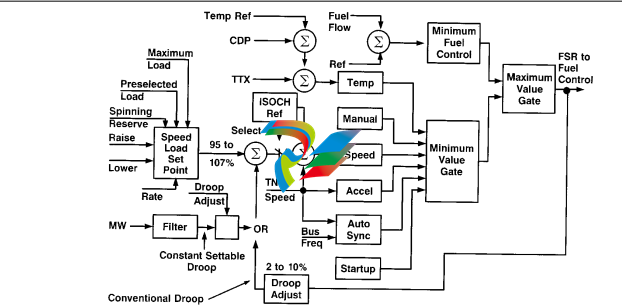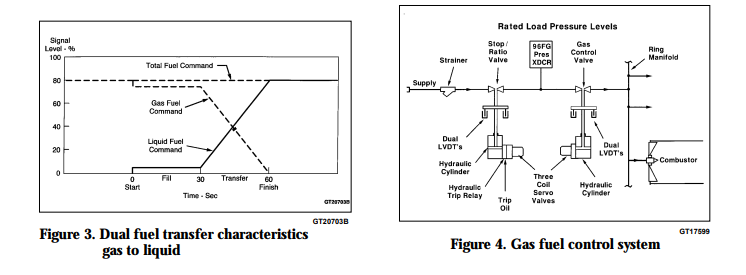
GESPEEDTRONIC™ MARK V GAS TURBINE CONTROL SYSTEM
without overspeeding
• Critical sensors are redundant
• Control is redundant
• Alarm any control system problems
• Standardize hardware and software to enhance reliability while maintaining flexibility


Figure 2. Gas turbine fuel control
under load are accomplished by transitioning
from one system to the other after an appropriate fill time to minimize load excursions. System
characteristics during a transfer from gas to liquid fuel are illustrated in Figure 3. Purging of
the idle fuel system is automatic and continuously monitored to ensure proper operation.
Transfer can be automatically initiated on loss of
supply of the running fuel, which will be
alarmed, and will proceed to completion without operator intervention. Return to the original fuel is manually initiated.
The gas fuel control system is shown schematically in Figure 4. It is a two-stage system, incorporating a pressure control proportional to
speed and a flow control proportional to fuel
command. Two stages provide a stable turndown ratio in excess of 100:1, which is more
than adequate for control under starting and
warm-up conditions, as well as maximum flow
for peak output at minimum ambient temperature. The stop/speed ratio valve also acts as an
independent stop valve. It is equipped with an
interposed, hydraulically-actuated trip relay that
can trip the valve closed independent of control
signals to the servo valve. Both the stop ratio
and control valves are hydraulically actuated,
single-acting valves that will fail to the closed
position on loss of either signal or hydraulic
pressure. Fuel distribution to the gas fuel nozzles in the multiple combustors is accomplished
by a ring manifold in conjunction with careful
control of fuel nozzle flow areas.
The liquid fuel control system is shown
schematically in Figure 5. Since the fuel pump is
a positive displacement pump, the system
achieves flow control by recirculating excess fuel





























































































































